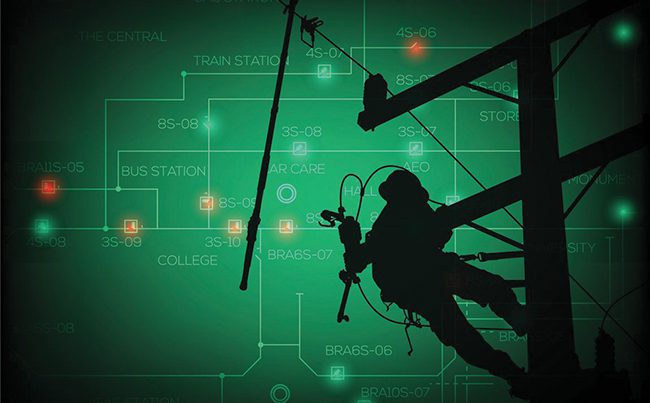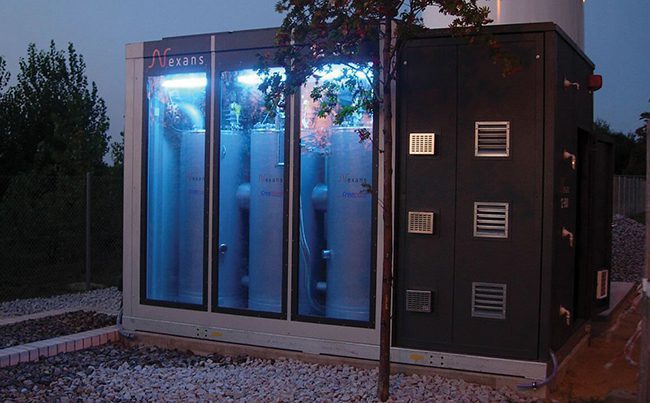Improving Power Networks: How Smarter Grids and a New Generation of Electricity Can Prevent Blackouts
Power networks today face two major challenges: aging infrastructure and complex intermittent power flows caused by the worldwide transition from fossil-based fuels to zero-carbon resources. With some of the world’s oldest energy networks and demand for electricity expected to increase 20% by 2030, the need to modernize U.S. grids has never been more critical.
Due to the increasing occurrences of extreme weather conditions, winter and summer months are now major tests for power networks and grid reliability. The National Centers for Environmental Information, part of the U.S. Department of Commerce’s National Oceanic and Atmospheric Administration (NOAA), reported that the U.S. experienced 18 “weather/climate disaster events with losses exceeding $1 billion each” during the first nine months of 2021. These incidents included the Texas freeze, Western wildfires, several hurricanes and other severe storms, flooding, and drought, with many resulting in widespread blackouts. Additionally, power networks are being further strained as global demand for electricity increases to meet society’s changing needs, such as supplying electric vehicle (EV) charging, year-round air conditioning, and constantly expanding data centers. Let’s look at the challenges and solutions to improving power networks, the main causes of disruption, and how smarter power grids and new generation of electricity can prevent blackouts.
The Challenges and Solutions to Improving Power Networks
As we enter a new year, power networks continue to face incredible challenges. These include the ever-increasing risk of the power grid’s obsolescence, the inadequate interconnection with neighboring states and countries, an imbalance between production and consumption, and the lack of underground power cables.
There are various options available to improve power networks. First, let’s explore mutualization through synchronous zones: the stability of grids is a quality of their regulation by which moderately disturbed situations gradually return to an equilibrium state. A large area operating at the same frequency, all alternators being synchronized, can absorb a local disturbance more easily. The benefit of pooling quantities goes beyond mutual assistance when disturbances occur: generation with lower costs and more security for the provisioning of reserves. It is also useful for better management of the load and has significant equalizing effects to avoid critical peaks. An attractive part of the large neutralization is it opens the market with greater offers and greater demand. It can combine long-term contracts and short-term power exchanges to meet the increasing variability of demand.
It has very few cons. There is higher complexity to manage due to physics on the larger area and calculating phenomenon. In case of blackouts, the impacted area is wider and longer, and more difficult to restart. The opposite position may be found in recommending to learn to live without power grids. It may be achieved in an “Act locally!” way of life, based on renewable energies and a storage capacity. However, it is more difficult to up-scale this option for larger purposes such as manufacturers and industrial applications.
Building power lines underground is a significant preventative measure to consider in improving power networks. This can reduce grid sensitivity due to atmospheric disturbances such as lightning, ice, sticky snow, and storms. Another measure to consider is keeping a power reserve in plants. This allows for dynamic increases in generation that can be more strategically leveraged with the increase of intermittent renewable energies. Interconnection with neighboring countries and use of specific power electronics systems are other ways to improve grid stability and power networks.
Main Causes of Blackouts
Total loss of power to an area—a blackout—is the most severe type of power outage. This may result from power stations tripping and has the risk of affecting surrounding areas. Deploying smarter power grids and a new generation of electricity can prevent blackouts. Let’s take a closer look at their four main causes.
The Cascade and Triggering of Transmission Line Overloads. The “Joule effect” occurs when a metal conductor transmits an electrical current and its temperature increases. The generated losses are roughly proportional to the square of the current rating; so, if the current is doubled, the losses are multiplied by four. The temperature rise follows the same trend, as seen in the 2003 blackout in the Northeastern U.S. when several transmission lines in Ohio failed suddenly.
Significant heating and damage to the components of the power link (overhead line or underground cable) may happen if the transmitted intensity is too high. In addition, for overhead lines, the heating of the conductors induces their elongation resulting in “the sag.” As the bare conductors on the line get closer to the ground, isolation distances are reduced, which increases the risk of tree ignition in the vicinity and damage to persons and property.
Before reaching a critical temperature, the power link is triggered (or switched off) by the dispatcher (the pilot of the transmission grid). However, when a line is switched off, its load is transferred to the connected lines of the meshed network along with the risk of spreading the overloads. If the situation is further tensed on the network, a cascade of triggering may happen, leading to a blackout.
Frequency Collapse. This is the lack of balance between generation and consumption, and can be illustrated by comparing the driving forces of the power plants and the resistive torque represented by the loads. Imagine the rotating speed of an alternator; if the demand exceeds the supply, the system is out of balance, the speed of the machines, and consequently the frequency of the network, drops. Conversely, if the supply is greater than the demand, the system sees the generating sets accelerate and the frequency increases.
Voltage Collapse. Voltage level is contractual with customers and control at any point of the electrical system is necessary to ensure correct behavior of the equipment. When the voltage decreases, bulbs light less well, causing the phenomenon known as brownout. This may be caused by overloaded circuits or intentionally by the utility company to reduce the amount of power drawn by customers. During a tense peak demand period, a brownout may be the first step to limit the risk of drifting toward a blackout.
The Break in Synchronism Between Generation Units. On an undisturbed network, all alternator rotors rotate at the same electrical speed, which is known as synchronous operation. The common speed defines the frequency of the electrical system. This synchronism is due to the existence of an elastic link called “synchronizing torque.” Everything happens as if the generators were bound together. To avoid dislocation, protections remove the non-synchronized generators, leading to the collapse of the network.
These four incidents may follow one another, overlap, or combine. The continuity of extreme weather incidents proves to us again that there are still significant challenges to improving power networks as we experience blackouts in record numbers. However, there are measures that can prevent blackouts. For example, with redundancy of power lines (n-k rule), a safety or security measure to cut one area to prevent the collapse of the rest of the area so the failure of a single line will not lead to an undesirable event.
In case of emergencies, local shedding plans can guard against major outages on a power grid that involve an imbalance between production and consumption. This means selective power cuts, which are controlled shutdowns of the power supply in a given area to contain the problem in that area. Non-essential uses are cut off from the network, while crucial functions, such as safety services and hospitals, are preserved.
Electric utilities may appeal to civic sense in critical situations. For example, the “EcoWatt” platform in France brings together a community of volunteers, who each get a text message when the transmission system operator foresees a peak period. They accept to reduce their electricity consumption for a few hours. The next step is a paid service. Electricity aggregators can set up a commercial agreement with consumers, especially industrial users with a high demand of electricity. Their flexibility is valued in electricity markets.
Smarter Power Grids and a New Generation of Electricity Can Prevent Blackouts
Smarter power grids usher in a new generation of electricity that can prevent blackouts. Using internet of things (IoT) and other technologies, smart grids provide real-time knowledge of the status of the generation-consumption balance and behavior of the grid, helping to instantly optimize available resources and flexibilities based on technical, financial, and environmental demands (Figure 1). This allows for better management of assets and increases performance for electricity utilities.
 |
|
1. Smart grids help to optimize the available resources and flexibilities in real time according to technical, financial, and environmental demands. Courtesy: Nexans |
IoT created an additional network of connected objects spanning generation plants, transmission and distribution lines, data centers, businesses, and homes, and provides a steady communication flow between various sections of the grid. Because of this enhanced information flow, smart grids allow utility providers to better manage energy consumption, reduce balancing costs, and level the demand curve to prevent load peaks. They also contribute to a better integration of a more diverse electricity mix, with significant renewable generation units. For example, customers are empowered to become informed through smartphone applications and more engaged in how to reduce energy consumption. However, as the lifespan of a transmission line is often about 50 years, the deployment of smart grids may be delayed by the required cohabitation of systems of different generation and suppliers.
There are also different types of innovations being used to help prevent blackouts such as interconnectors. Mentioned earlier, interconnectors with neighboring areas increase grid stability, mutualization, and solidarity. Several large areas at the scale of more than 10 countries are then organized on the continents to operate at the same frequency. For example, the increasing use of high-voltage direct-current (HVDC) technologies makes bulk transmission of electricity over long distances possible, allowing for connections with islands and spanning continents in the future—scientific working groups have even considered a global grid.
Superconducting cable systems (Figure 2) are another innovation that are commercially used in distribution systems and bring an efficient solution to congested areas. The most recent example is the “Resilient Electric Grid” project in Chicago, where a superconducting system strengthened the existing grid by protecting against extreme weather and other catastrophic events. Ambitious projects such as the European “Best Paths” project have been considered to connect long distances by integrating large-scale renewable energies and interconnections.
 |
|
2. Superconducting systems can play a key role in improving the resiliency of power grids by protecting against extreme weather and other catastrophic events. Courtesy: Nexans |
There are ways to improve networks in the near term, such as regular maintenance and training, moving to refurbished systems, and relying on asset management methods for a better targeted renewal plan and prioritization of relevant investments. As power networks face significant challenges, improving and planning in the long term, especially with the long lifetime of grid components, requires large investments, innovation, and experimentation.
—Frédéric Lesur is a senior engineer specializing in high-voltage products and cable systems with Nexans.